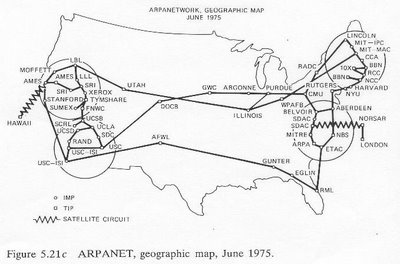PHOTO: ARPANET geographic map in June, 1975, showing U.S. connections and satellite links to Hawaii and London, is from a book by Leonard Kleinrock 'Queuing Systems, Vol. II: Computer Applications,' 1976, p. 309.
 PHOTO: Book jacket showing M.C. Escher drawing of endless staircase for Leonard Kleinrock, 'Queuing Systems, Vol. II: Computer Applications,' 1976, p. 309. Both volumes I and II of this book were required texts for a graduate level electrical engineering class that I took back then. The professor teaching the class had worked with Kleinrock and IBM researchers who developed networking technology that formed the basis for the present day Internet. As part of his research, he planned to put a satellite receiver on the roof of the Oregon State University Dearborn Hall and connect to ARPANET via the Hawaii node. (See Wikipedia: ARPANET and previous post OSU Internet research 1975 (9/2/06))
PHOTO: Book jacket showing M.C. Escher drawing of endless staircase for Leonard Kleinrock, 'Queuing Systems, Vol. II: Computer Applications,' 1976, p. 309. Both volumes I and II of this book were required texts for a graduate level electrical engineering class that I took back then. The professor teaching the class had worked with Kleinrock and IBM researchers who developed networking technology that formed the basis for the present day Internet. As part of his research, he planned to put a satellite receiver on the roof of the Oregon State University Dearborn Hall and connect to ARPANET via the Hawaii node. (See Wikipedia: ARPANET and previous post OSU Internet research 1975 (9/2/06))
The history of the internet is quite rich. One of the fathers of the internet, Vint Cerf (See Wikipedia), talks about it in a very interesting TV program: "History of the Internet (The Evolution of the internet) Panetta (Leon and Sylvia) Institute" C-SPAN Video Library, posted May 28, 2012 -- "Technology experts and journalists talked about the history, evolution and future of the internet. They touched on a wide variety of topics including the impact of new technologies and communications media on society, the use of social media to influence popular and political culture, Internet use in business, and how the Internet had changed news media. They also interacted with the audience. 1 hour, 57 minutes.
The history of the internet just got richer with the following two feature stories in a traditionally straight establishment business magazine:
- Paul M. Barrett, "The New Republic of Porn," BusinessWeek, June 25 to July 1, 2012, p. 58-64 posted on June 21, 2012 -- ""We didn't know whether, if we built it, people would come," Lawley concedes. He need not have worried. Last October, Corbin Fisher, a major gay studio in Las Vegas, said it would pay $500,000 for gay.xxx (the site is still under construction). In December, Clips4Sale, a downloadable video site, announced a $700,000 all-cash deal for a package of 30 premium names. Those big chunks of cash go to ICM. "We won," says Lawley."
- Brad Stone, "The Talented M. Despallières," BusinessWeek, July 2-8, 1012, p. 56-61 posted on on June 28, 2012 -- "Despallières's flamboyant arrival on the London scene immediately angered Ikin's family and friends. Over the years, Ikin had meticulously revised several wills that divided his wealth between charities and his extended family. His family in Australia challenged the will in British court. The ensuing legal confrontation received ample attention from the tabloids. ("Young gay husband Alexandre Despallières gets Peter Ikin millions in will" read one headline in the Telegraph, a Sydney paper.)"
I was amazed when the first gay story in BusinessWeek showed up last week, but I was even more amazed to see two gay feature stories two weeks in a row! I heard on the news that new xxx internet domains mentioned in the first article are on hold (I haven't confirmed this) and I loved reading the second story's connection to a Japanese online porn company. It is becoming a small world after all.
